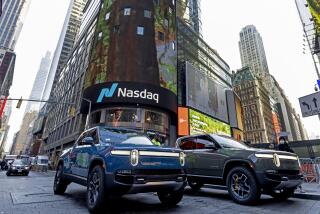Rover Group Emerges From Years in Auto Wilderness
- Share via
SOLIHULL, England — Britain’s largest car maker, Rover Group Ltd., builds its famed four-wheel-drive Land Rovers in an old aircraft factory that still sports dark patches of World War II-era camouflage paint.
The fading paint scheme originally was meant to ward off attacks by German bombers, but it also serves as a handy symbol of Rover’s embattled financial condition after decades of labor strife, shoddy workmanship and ownership changes.
Now, after hemorrhaging cash for at least four straight years, the company is finally showing signs of transforming into an aggressive, world-class competitor.
Buoyed by rising Land Rover sales and plans to launch an updated version of its Mini micro-car, Rover is reinventing itself also as a maker of luxury sedans.
“On the surface, Rover may look like a still-troubled company,” says Christopher Will, European auto analyst at U.S. investment bank Lehman Brothers. “If you look under the skin, Rover is about to burst out with new products, and the bills for those products have mostly been paid already.”
More is at stake than Rover and the jobs of its 30,000 workers.
The company’s owner, Germany’s BMW, has invested over $3 billion in Rover since buying the company in 1994--a move that in itself symbolized the shared destinies of former wartime foes.
BMW’s own success depends heavily on Rover’s ability to sell its redesigned mainstream passenger cars while also boosting sales of niche vehicles such as the sporty MG and cult-classic Mini.
“There is no question about our commitment to Rover,” said Jurg Dinner, a spokesman for Munich-based BMW. “Our British brands--Rover, Land Rover, Mini and MG--are part of our long-term multi-brand strategy.”
Rover plans to open a new facility next year to expand production of the 10-foot-long Mini, for sale primarily to enthusiasts in Europe and Japan.
As part of Rover’s revival, the company also expects to increase exports to the United States, where it currently sells only the four-wheel-drive Discovery and Range Rover models that it makes at Solihull in central England. In time, passenger cars, including the Mini, also could be available in U.S. showrooms.
Rover’s previous effort to sell cars to Americans was a disaster, due to quality problems with its Sterling sedan.
“When we go back into America, we have to go back in a quality way,” Rover spokesman Vincent Hammersley says.
But first, the company must generate enthusiasm for its new car models--the mid-size Rover 25 and 45 and the top-end Rover 75.
The company, headquartered in Warrick, central England, lost $1.06 billion last year on sales of $11.6 billion.
It sold only 327,778 vehicles during the first nine months of this year, 16% fewer than in the same period of 1998. Although it sold 19% more Land Rovers, car sales plunged by almost a third.
Rover blames this bruising largely on the strong British pound, which has made its vehicles more expensive than competing products priced in other currencies. But Hammersley acknowledges that productivity hasn’t been as good as it could be and said the company doesn’t expect to turn a profit before 2002.
Still, analysts and auto historians agree that Rover has made huge strides since it became part of the British Leyland Motor Corp. and was nationalized in 1974.
British Leyland suffered from anarchic labor relations and dubious engineering. One of its biggest flops was the Austin Allegro, a hearse-shaped car notorious for its square steering wheel.
British Aerospace bought Rover in 1988, sold a share of it to Honda of Japan, then unloaded the whole company to BMW. BMW, which is partially publicly traded, paid the equivalent of $1.32 billion in today’s dollars for Rover.
“At the time BMW took it over, it probably had the worst production economics of any Western company,” says John Lawson, an analyst at Salomon Smith Barney.
BMW wanted to enter the market for high-end sports utility vehicles, and analysts say it accepted Rover’s uninspiring passenger cars as part of the deal.
The German company has since retooled Rover’s biggest factory, a car plant in the Birmingham suburb of Longbridge, and pledged to invest an additional $5 billion in the company over the next five years.
At the same time, BMW is telling Rover’s suppliers to drop their prices by 10% and accept payment in euros rather than pounds.
Rover aims to double its current output of 500,000 vehicles by 2004 and cut costs by reducing its product line to 8 models from 14.
A turnaround already may be at hand. Rover’s share of the British market increased to 5.8% in September, compared to 3.4% the previous year, according to BMW.
As a result, Will, of Lehman Brothers, predicts that Rover will halve its losses from this year to the next.
But much depends on the Rover 75, launched in June. The luxury sedan is Rover’s first car to contain a large number of BMW parts, though its chrome grill and inlaid wood interiors evince a style that is all British.
Rover is playing down signs of sluggish demand for the 75, despite the skepticism of some analysts.
“To expect an immediate, very heavy sales volume in a new executive car just isn’t realistic,” spokesman Nick Argent says. “We’re bang on target.”






